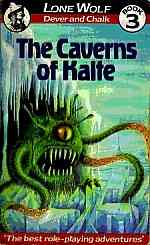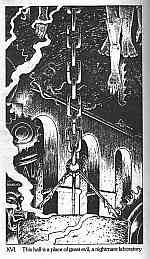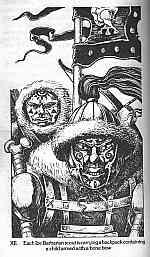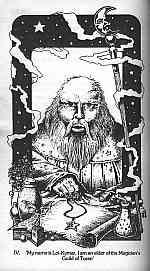
Main Page
 Main Page |
The Kai Monastery |
With that promise, King Ulnar V sets in motion the third adventure in the Lone Wolf series, The
Caverns of Kalte. Lone Wolf must hunt down Vonotar the Traitor in one of the most
inhospitable environments in all of Magnamund, the frozen polar region of Kalte, north of
Sommerlund. Vonotar betrayed Sommerlund to the Darklords in order to learn the secrets of
right-handed magic. Thus began a war that opened with the slaughter of the Kai warriors (see Flight From the Dark) and ended with the defeat of Darklord
Zagarna at the siege of Holmgard (see Fire on the
Water).
The adventure takes place over land first, as Lone Wolf treks to Ikaya, the ice fortress where
Vonotar is hiding, and then the story switches to a dungeon-style adventure as Lone Wolf makes his
way through the fortress to the traitorous wizard. The only recurring character in the book is
Vonotar himself. The other characters are well presented but never appear in other books.
The book was first published in 1984. The copy I have bears no other printing information,
indicating that it is part of the original print run. However, I am not certain that is true. Sparrow
books was the original publisher of Lone Wolf books, and I have seen Sparrow editions of books
three, four and five. This suggests that Beaver Books may not have started publishing Lone Wolf
books until the time of book six. So, it seems likely that my copy of book three was a reprint in the
Beaver style after Beaver took over publishing Lone Wolf books.
The Caverns of Kalte is an enigmatic adventure; it is many things at once. It offers several
variations in its story, yet the story is mostly immutable. It sends the reader off towards a clear
objective, yet it does not reveal all the details of Vonotar's residency at Ikaya until near the end of
the story. It bears much of the style of the previous two Lone Wolf books, yet it introduces many
innovations which become convention in later books.
At the beginning of the book, the reader is faced with a choice: the long, easier route to Ikaya, or the
shorter, harder route. Each path itself is quite linear, but with a few variations along the way which
make them each worth re-reading. Eventually, Lone Wolf will fall into the Caverns of Kalte, great
underground passages constructed by the ancients. Depending on the entry point, several different
encounters await. Yet, the entry to the caverns is inevitable. Within Ikaya, it is a similar story:
there is only one way to get to Vonotar, yet along the way the reader can visit many different rooms
in the fortress.
An experienced reader who was paying close attention in books one and two and who read them a
few times will have already pieced together the essence of Vonotar's story. But for a first time
reader, the nature of Vonotar's treachery is unclear. Still, the mission is straightforward enough:
reach Ikaya and catch the villain. Background information about Vonotar is available in the book,
but it only comes through the mouth of Loi-Kymar. This discovery can add to the excitement of the
book. Or it can dampen the experience if the reader wants to know what Loi-Kymar has to say
when they are standing on the Ljuk ice shelf.
Along with the fantastic setting and storyline of book three come some new playing features. Book
three is the first time we see Kai Disciplines modify random number choices. It is also the first time
random number choices are used extensively to determine Lone Wolf's success at major actions in
the story. Both these features are staples of later books. Their appearance marks a significant
development in the sophistication of the series.
Book three is just about devoid of lapses and oversights. However, it seems odd at the end when the
text tells you it is with a sad heart you leave your guides behind, since depending on how you
reached the ice fortress, your guides may still be alive! Wouldn't a good Sommlending ship wait for
them?




 "The news that Vonotar still lives spreads like wildfire throughout Sommerlund.
Thousands of Sommlending surround the capital and demand that Vonotar be made to pay for his
treachery. So great is the outcry that the King is obliged to promise that the evil traitor will be
brought back to Holmgard, and made to stand trial for his crimes."
"The news that Vonotar still lives spreads like wildfire throughout Sommerlund.
Thousands of Sommlending surround the capital and demand that Vonotar be made to pay for his
treachery. So great is the outcry that the King is obliged to promise that the evil traitor will be
brought back to Holmgard, and made to stand trial for his crimes." A further complication to the publishing saga is the fact that the first Beaver editions of books one,
two and five bear the same cover illustration as the Sparrow editions (at least, this is true for the
editions I have seen). However, the Beaver editions of books three and four bear different cover
illustrations from the Sparrow editions. If anyone knows more about this whole issue, please fill me in.
A further complication to the publishing saga is the fact that the first Beaver editions of books one,
two and five bear the same cover illustration as the Sparrow editions (at least, this is true for the
editions I have seen). However, the Beaver editions of books three and four bear different cover
illustrations from the Sparrow editions. If anyone knows more about this whole issue, please fill me in. This linearity is true of other Lone Wolf books, but in book three the variations which are presented
are often small and inconsequential to the plot. They are there more for show than for substance;
they tell a great deal about Kalte but less about the adventure. The outcome of the side encounters
has little bearing on the outcome of the story, let alone the manner that story unfolds. There is a
certain inevitability to The Caverns of Kalte.
This linearity is true of other Lone Wolf books, but in book three the variations which are presented
are often small and inconsequential to the plot. They are there more for show than for substance;
they tell a great deal about Kalte but less about the adventure. The outcome of the side encounters
has little bearing on the outcome of the story, let alone the manner that story unfolds. There is a
certain inevitability to The Caverns of Kalte. The Caverns of Kalte is a fun read. It has a powerful and important story in a rich setting, a
hallmark of the Lone Wolf books. It plays upon one of the great mini sagas of the entire series:
Vonotar's betrayal of the Kai and his eventual capture by the last of the Kai Lords. It also shows the
evolution of the series by presenting a more polished and professional set of gaming conventions.
Despite its linearity, the book is a marked step forward which continues in the strong tradition of the
first two.
The Caverns of Kalte is a fun read. It has a powerful and important story in a rich setting, a
hallmark of the Lone Wolf books. It plays upon one of the great mini sagas of the entire series:
Vonotar's betrayal of the Kai and his eventual capture by the last of the Kai Lords. It also shows the
evolution of the series by presenting a more polished and professional set of gaming conventions.
Despite its linearity, the book is a marked step forward which continues in the strong tradition of the
first two.
© Julian Egelstaff 1997-2000
Lone Wolf © TM Joe Dever 1984-2000